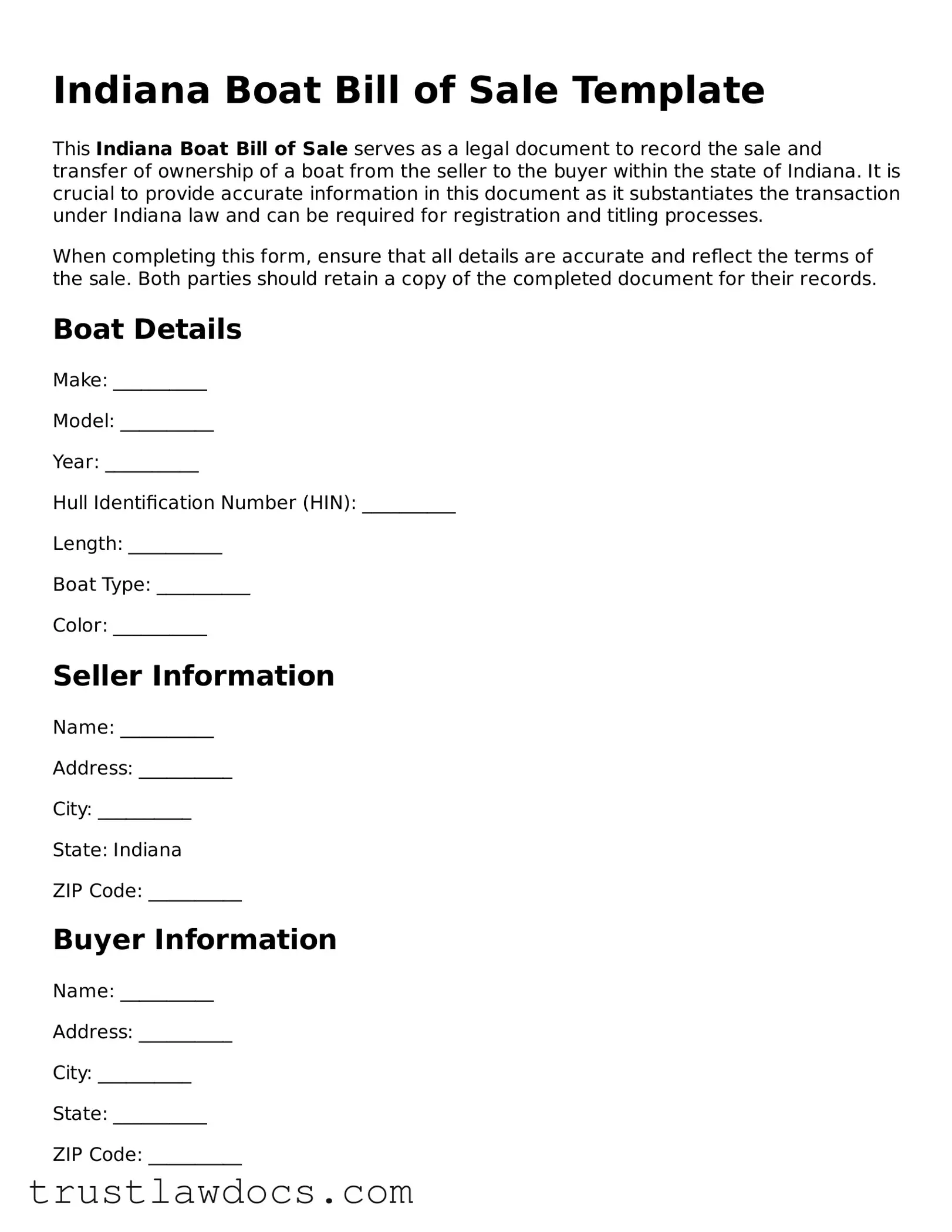The Indiana Boat Bill of Sale is similar to a Vehicle Bill of Sale, as both serve to document the sale and transfer of ownership of personal property. In the case of the vehicle document, it covers automobiles, motorcycles, and similar types of transportation. Each document typically contains details such as the make, model, year, and identification number of the property, as well as the names and signatures of the buyer and seller, and the sale date and price. These forms are crucial for registration and titling purposes and serve as proof of ownership.
It also shares similarities with a General Bill of Sale, which is used for transactions involving various items that don't fit into more specific categories, like electronics, equipment, or personal possessions. While the General Bill of Sale is broader in scope, both forms function as legal records that outline the details of a sale, including the parties involved, the item sold, the sale amount, and the date of the transaction, thereby providing legal protection for both buyer and seller.
A Real Estate Bill of Sale parallels the Boat Bill of Sale regarding their function in recording the sale of a significant asset. However, the real estate version is used for transactions involving property such as land or buildings. Despite the different types of property they concern, both documents ensure the legal transfer of ownership and include information on the asset, the sale agreement, and the parties involved.
An Aircraft Bill of Sale is another comparable document, designed for transactions involving airplanes and other aircraft. Like the boat bill of sale, this document requires detail about the make, model, and serial number of the aircraft, as well as the names and addresses of the buyer and seller. Both documents are vital for the proper registration and proof of ownership of the vehicle in question.
The Indiana Boat Bill of Sale bears resemblance to a Firearm Bill of Sale, which documents the sale and transfer of a gun. While significantly different in the type of item sold, both documents contain vital information about the transaction, such as a description of the item, identification numbers (if applicable), and the particulars of the buyer and seller. These documents act as a pivotal record for ownership and, in the case of firearms, may be required for background checks or licensing.
Similar to a Horse Bill of Sale, the Indiana Boat Bill of Sale records the transfer of ownership of a living animal. Although one documents a boat and the other a horse, both forms contain specific details about the item being sold, including any identification marks or numbers, the sale price, and the agreement's date. These documents also usually include conditions of the sale, such as warranties or return policies.
A Business Bill of Sale can be likened to the Indiana Boat Bill of Sale in its role in transferring ownership, this time of an entire business rather than an item. While the former covers the sale of a company's assets, stock, or ownership interest, the latter focuses on a singular asset. Nonetheless, both outline the transaction details, including the parties involved, the assets being transferred, and any terms or conditions of the sale.
The Indiana Boat Bill of Sale shares characteristics with an Equipment Bill of Sale, especially when the boat sale includes trailers or other related equipment. Both forms document the sale of machinery or equipment, detailing specifics such as make, model, and serial number, in addition to the standard sale information. They serve a key role in confirming the deal and transferring ownership officially.
Similarly, a Mobile Home Bill of Sale is aligned with the boat bill of sale, focusing on mobile homes as the subject of the transaction. Both documents formalize the sale of a significant asset that requires proper documentation for ownership and, potentially, relocation purposes. They include comprehensive details on the asset, the sale price, and parties' information, ensuring a clear transfer of ownership.
Lastly, an Artwork Bill of Sale can be seen as akin to the Indiana Boat Bill of Sale because both deal with an exchange involving valuable assets. Art transactions, much like boat sales, necessitate specific details regarding the piece being sold, including its creator, authenticity, and condition. This parallel emphasizes the importance of documenting the provenance and ownership transfer of high-value items, whether they're tangible assets like boats or pieces of art.
